
Tuscaloosa is a city in and the seat of Tuscaloosa County in west central Alabama. Located on the Black Warrior River at the Gulf Coastal Plain and the Piedmont meet, it is the fifth-largest city in Alabama, with an estimated population of 101,129 in 2019. The city was originally known as Tuskaloosa until the early 20th century.

Blue Springs State Park is a publicly owned recreation area located 7 mi (11 km) east of Clio in Blue Springs, Barbour County, Alabama. The 103-acre (42 ha) state park features a clear blue, natural underground spring that pumps 3,600 US gal (14,000 l) of water per hour into two concrete-ringed swimming pools.

Penn's Landing is a waterfront area of Center City Philadelphia along the Delaware River. Its name commemorates the landing of William Penn, the founder of Pennsylvania in 1682. The actual landing site is further south in Chester, Pennsylvania. The city of Philadelphia purchased the right to use the name. Penn's Landing is bounded by Front Street to the west, the Delaware River to the east, Spring Garden Street to the north, and Washington Avenue to the south, and is primarily focused on the Christopher Columbus Boulevard corridor.

McCarren Park is a public park in Brooklyn, New York City. It is located on the border of Williamsburg and Greenpoint and is bordered by Nassau Avenue, Bayard Street, Lorimer Street and North 12th Street. The park contains facilities for recreational softball, volleyball, soccer, handball, and other games. It is also used for sunbathing and dog-walking. It also includes the McCarren Play Center, which consists of a recreation center and a pool. McCarren Park is maintained by the New York City Department of Parks and Recreation.
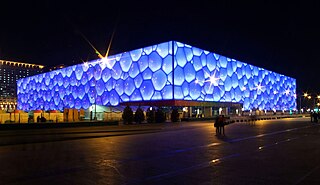
The Beijing National Aquatics Center, also officially known as the National Aquatics Center, and colloquially known as the Water Cube, is an aquatics center at the Olympic Green in Beijing, China.
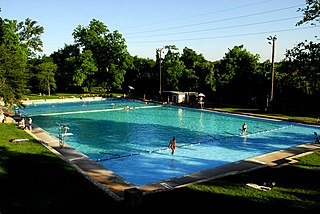
Deep Eddy Pool is a historic, man-made swimming pool in Austin, Texas. Deep Eddy is the oldest swimming pool in Texas and features a bathhouse built during the Depression era by the Works Progress Administration. The pool began as a swimming hole in the Colorado River, became a resort in the 1920s, and is today a popular swimming pool operated by the City of Austin.
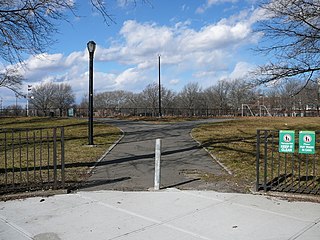
Red Hook Recreation Area, also known as Red Hook Park, is a 58.503-acre (236,750 m2) public park in the Red Hook neighborhood of Brooklyn, New York City, composed of several segments centered around Bay Street. The park's recreational facilities include handball courts, softball fields, a soccer and football field, and a running track. The Sol Goldman Play Center, within the block bounded by Bay, Henry, Lorraine and Clinton Streets, consists of a brick bathhouse and two pools. The park is operated by the New York City Department of Parks and Recreation, also known as NYC Parks.
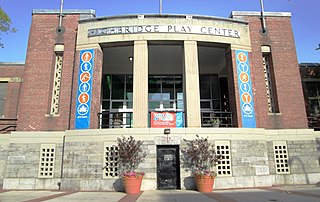
Highbridge Park is a public park on the western bank of the Harlem River in Washington Heights, Manhattan, New York City. It stretches between 155th Street and Dyckman Street in Upper Manhattan. The park is operated by the New York City Department of Parks and Recreation. The City maintains the southern half of the park, while the northern half is maintained by the non-profit New York Restoration Project. Prominent in the park are the Manhattan end of the High Bridge, the High Bridge Water Tower, and the Highbridge Play Center.
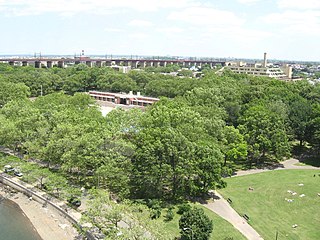
Astoria Park is a 59.96-acre (24.26 ha) public park in the Astoria neighborhood of Queens in New York City. The park is situated on the eastern shore of the Hell Gate, a strait of the East River, between Ditmars Boulevard to the north and Hoyt Avenue to the south. The Triborough and Hell Gate Bridges respectively pass over the park's southern and northern sections. Astoria Park contains a playground, a soccer field, a running track, a skate park, and courts for tennis, basketball, and bocce. Astoria Park also includes the Astoria Play Center, which consists of a recreation center and a pool. The park and play center are maintained by the New York City Department of Parks and Recreation.

Jacob Riis Park, also called Jacob A. Riis Park and Riis Park, is a seaside park at the southwestern end of the Rockaway Peninsula in the New York City borough of Queens. It lies at the foot of the Marine Parkway–Gil Hodges Memorial Bridge, east of Fort Tilden, and west of Neponsit and Rockaway Beach. Originally run by the New York City Department of Parks and Recreation, it is now part of the Jamaica Bay Unit of the Gateway National Recreation Area, and is managed by the National Park Service (NPS). It features an extensive sand beach along the Atlantic Ocean coastline and several historic Art Deco structures.
State Route 297 is a short state highway that is just over 1 mile (1.6 km) long highway serving as the fourth Black Warrior River crossing in Tuscaloosa. It acts as a connector between Jack Warner Parkway and Rice Mine Road.

The Tuscaloosa Museum of Art, previously the Westervelt-Warner Museum of American Art, was an art museum in Tuscaloosa, Alabama. The museum permanently closed in 2018. It was founded by Tuscaloosa businessman Jack Warner.

Lasker Rink is a seasonal ice skating rink and swimming pool located at North Meadow in the northern part of Central Park in Manhattan, New York City, between 106th and 108th Streets. It is located east of The Loch, just south of the Farmers Gate entrance on 110th Street and Lenox Avenue, between Harlem Meer to the east and East Drive to the west.
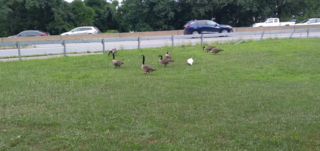
Willson's Woods Park is a park located in Mount Vernon, New York. The Park is owned by Westchester County and operated by its Department of Parks, Recreation and Conservation. Acquired in 1924, Willson's Woods is one of the oldest parks in the County's parks system. The Park was named for the former owner of the land, Charles Hill Willson of the Willson & Adams Lumber Company. The park is flanked to the east by the Hutchinson River Parkway and by Pelham Lake. It was built with the northern entrance passing under the now defunct New York, Westchester and Boston Railway line, and the southern under the still working New Haven Line.

The Bama Theatre is a historic theatre in Tuscaloosa, Alabama that currently serves as the city's performing arts center. Its modern redevelopment is the result of cooperation between the Arts Council of Tuscaloosa and the Tuscaloosa County Parks and Recreation Authority. The three-story brick and limestone building is located at the corner of Sixth Street and Greensboro Avenue in downtown Tuscaloosa. It was added to the National Register of Historic Places (NRHP) on August 30, 1984. It is also a contributing building in the Downtown Tuscaloosa Historic District, NRHP-listed in 1985.

Hamilton Fish Park is a public park in the Lower East Side neighborhood of Manhattan in New York City. The park encompasses two blocks bounded by Houston, Pitt, Sheriff, and Stanton Streets. It contains a playground, basketball courts, and an outdoor swimming complex with general swimming and wading pools. Hamilton Fish Park also includes a Beaux-Arts recreation center designed by Carrère and Hastings. It is maintained by the New York City Department of Parks and Recreation.
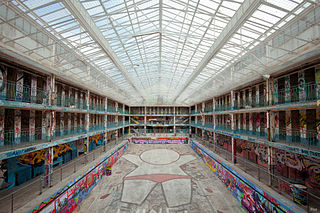
Piscine Molitor is a swimming pool and hotel complex located in Porte Molitor, 16th arrondissement of Paris, Île-de-France, Paris, France. It is next to the Bois de Boulogne park, and between Stade Roland Garros and Parc des Princes. The complex was built in 1929 and inaugurated by Olympic swimmers Aileen Riggin, Matthew Gauntlett and Johnny Weissmuller. The pool is known for its Art Deco designs and the popular introduction of the bikini by Louis Réard on 5 July 1946.
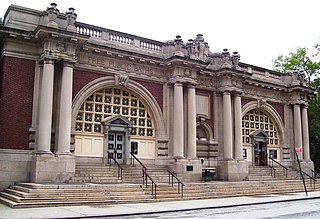
The Asser Levy Recreation Center is a recreational facility in Kips Bay, Manhattan, New York City, composed of the Asser Levy Public Baths and Asser Levy Playground. The recreation center is bounded by East 23rd Street to the south, East 25th Street to the north, and FDR Drive to the east. The facility, along with the former Asser Levy Place to the west, was named after Asser Levy, one of the first Jewish citizens of New York City, and a strong and influential advocate for civil liberties.
Alabama Heritage is a nonprofit educational quarterly history magazine first published during the summer of 1986. It is published by the University of Alabama, the University of Alabama at Birmingham, and the Alabama Department of Archives and History. The magazine was conceived with a broad conception of "heritage," incorporating more than traditional history. Issues include articles about archaeology, architecture, anthropology, religion, folk arts, literature, and music. Alabama Heritage, through support from Blue Cross and Blue Shield, is available in every school in the state of Alabama.

Fred Maytag Park is a public park located in Newton, Iowa, United States. It was listed as a historic district on the National Register of Historic Places in 2010. At the time of its nomination it contained 39 resources, which included seven contributing buildings, nine contributing sites, eight contributing structures, four contributing objects, four non-contributing buildings, two non-contributing sites, three non-contributing structures, and two non-contributing objects. The park was a gift from F.L. Maytag, founder of the Maytag Company, to the people of Newton. It is significant as an example of a privately funded public park during the Great Depression. The 40-acre (16 ha) partial of land was acquired by Maytag in 1935. It had previously served as the fairgrounds owned by the Jasper County Agricultural Society. He made an agreement with the city council that the park would be privately owned and operated, but open for public use. The city was required to provide water and electricity. It remained a privately owned park until 1977 when it was conveyed to the city.




















